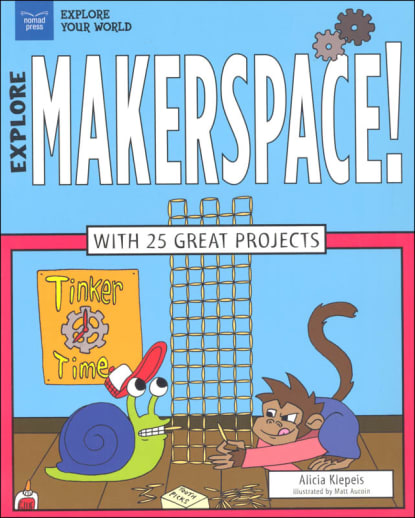A makerspace is a place to explore engineering projects: a dedicated place full of materials to use to explore engineering concepts. Create your own at home with this book and then get to learning! Learn how to build in various environments; study the science of sound and light; explore technology—and more—all in the comfort of your own home.
Explore Makerspace! (Explore Your World)
Description
Bridges, furniture, musical instruments, games, vehicles—all of these things were invented and improved upon by people who love to put stuff together, take stuff apart, and figure out how things work!
In Explore Makerspace! With 25 Great Projects, readers ages 7 through 10 explore what it means to be an engineer. They discover how inventors use science, art, and math to create new and exciting structures, games, and more. Readers also learn how to set up their own makerspaces at home, using inexpensive and easy-to-find supplies for their tinkering projects.
Humans have been inventors throughout history. From the wheel to the rocket, scientists and other engineers have designed new technologies that have made daily life easier and stretched our horizons far beyond our own atmosphere. But inventions don't have to be full of computer chips or other sophisticated parts. Designing the fastest toy car made from recycled materials can be just as thrilling!
Makerspaces can be found in schools, libraries, community centers, and homes all around the country. These are places where both children and adults can work with materials and use the engineer design process to come up with new ideas. Here, imagination, art, and logic combine to produce lasting lessons in science, math, and physics.
In Explore Makerspace! With 25 Great Projects, readers learn how to think proactively when faced with a challenge and discover the trial-and-error processes that lead to new discoveries. They find out about the motivation behind some of the world's most amazing inventions. Through STEAM projects ranging from designing a bridge to creating board games and musical instruments, children discover how to be an engineer.
This series explores STEM concepts and applied sciences. Each book includes 25 projects, averaging a few each chapter. Projects can vary from the simple (like making ocean salt water or forming an arch with your body) to more complicated STEAM projects (wind force; building design; or learning binary code). Adult supervision recommended for these kid-friendly projects. Call-Out sections include explanatory text, vocabulary with definitions, "Did you Know?" sections (with cool "factoids"), Investigate questions, project directions—and even "dad jokes." Throughout each book, periodic QR codes help readers explore additional concepts on external websites. You'll be able to choose from a few activities or match an activity to your child's appropriate grade—or have your budding scientist engage in them all! Includes a theme-focused timeline, essential questions, metric conversions, glossary, resources, and index. See each product description for specific content. Printed in the U.S. Size is 8"x 10". 90 pgs, pb. ~ Ruth
| Product Format: | Paperback |
|---|---|
| Grades: | 2-5 |
| Brand: | Nomad Press |
| ISBN: | 9781619305663 |
| Length in Inches: | 10 |
| Width in Inches: | 8 |
| Height in Inches: | 0.25 |
| Weight in Pounds: | 0.55 |

